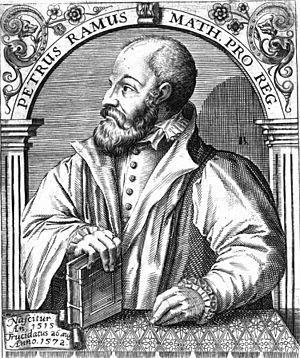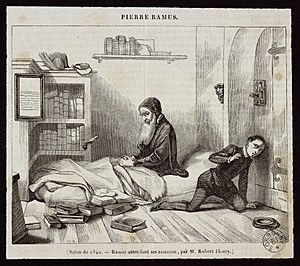Petrus Ramus facts for kids
Quick facts for kids
Petrus Ramus
|
|
|---|---|
 |
|
| Born |
Pierre de La Ramée
1515 Cuts, Picardy
|
| Died | 26 August 1572 (aged 56–57) Paris
|
| Nationality | French |
| Education | Collège de Navarre |
|
Notable work
|
Aristotelicae Animadversiones |
| Era | Renaissance philosophy |
| Region | Western philosophy |
| School | Renaissance humanism Ramism |
| Institutions | Collège de France |
| Thesis | Quaecumque ab Aristotele dicta essent, commentitia esse (Everything that Aristotle has said is false) (1536) |
| Academic advisors | Johannes Sturm |
| Notable students | Theodor Zwinger |
|
Main interests
|
Logic, educational reform |
|
Notable ideas
|
Ramism |
|
Influences
|
|
|
Influenced
|
|
Petrus Ramus (also known as Peter Ramus) was an important French thinker, born in 1515. He was a humanist, which means he focused on human values and abilities. He was also a logician, someone who studies how we reason, and an educational reformer who wanted to make learning better.
Ramus became a Protestant Christian. Sadly, he was killed during a terrible event in Paris called the St. Bartholomew's Day massacre in 1572.
Contents
Early Life and Education
Petrus Ramus was born in a small village called Cuts in Picardy, France. His father was a farmer. When he was about 12 years old, around 1527, he got into the Collège de Navarre. He worked there as a servant to pay for his studies.
During this time, many people were starting to question old ways of thinking. In 1536, Ramus earned his master's degree. For his final paper, he supposedly argued that "Everything that Aristotle has said is false." Aristotle was a very famous ancient Greek philosopher. This idea was quite bold for the time!
Starting His Academic Career
After finishing his studies, Ramus began teaching at the university. He got into many arguments with other scholars. One of his main opponents was Jacques Charpentier, a professor of medicine. Charpentier accused Ramus of trying to destroy the foundations of philosophy and religion.
The arguments became so serious that the matter went to the parlement (a high court) in Paris. Eventually, even King Francis I got involved. A special group decided that Ramus had "acted rashly" and stopped him from teaching in 1544.
Royal Support and New Challenges
Ramus left Paris for a short time. But soon, the new King Henry II came to power in 1547. With the help of a powerful cardinal, the ban against Ramus was lifted. He returned to Paris and got a job at the Collège de Navarre.
In 1551, King Henry II made him a professor at the famous Collège de France. Ramus asked for a special title: Professor of Philosophy and eloquence. For a while, he taught huge audiences, sometimes with as many as 2,000 students!
However, he still faced opposition. Another professor, Pierre Galland, criticized Ramus for his views on Aristotle. He even called Ramus a "parricide," meaning someone who harms their intellectual parent.
Life After Becoming a Protestant
In 1561, Ramus became a Protestant. This caused him a lot of trouble because France was mostly Catholic, and there was much conflict between the two groups. He had to run away from Paris. His home was robbed, and his valuable library, full of books, was burned.
He returned to his teaching job for a while. But in 1568, the situation became dangerous again. He decided it was best to ask for permission to travel.
Ramus spent about two years traveling in Germany and Switzerland. He returned to France but sadly became a victim of the St. Bartholomew's Day Massacre in 1572. This was a terrible event where many Protestants were killed. Ramus was hiding in a bookshop but returned to his home on August 26. He was stabbed while praying.
Ramus as an Educator
Ramus was very interested in how people learn and teach, which is called pedagogy. He believed that the way philosophy was taught at the time was confusing. He wanted to make learning simpler and more organized.
In 1543, he published two important books: Aristotelicae Animadversiones (a criticism of old logic) and Dialecticae Partitiones (a new textbook on logic). He later updated these books. His book Dialectique (1555) was the first book about logic written in the French language.
Ramus suggested using summaries, headings, and examples to make learning easier. He thought that organizing knowledge into clear outlines would help people understand things better. Some experts believe his methods helped change how different subjects were taught in schools by the end of the 1500s.
Ramus as a Logician
Ramus's ideas about logic became very popular for a time. Many people in France, Germany, Switzerland, and the Netherlands followed his teachings. These followers were known as Ramists.
Ramus tried to improve on Aristotle's system of logic. He simplified the syllogism, which is a way of reasoning with two statements that lead to a conclusion. He also changed how the parts of a syllogism were understood.
Ramus as a Rhetorician
Rhetoric is the art of speaking or writing effectively to persuade people. Traditionally, rhetoric had five main parts. Ramus believed that rhetoric and logic should be separated. He thought logic should handle "invention" (coming up with ideas) and "judgment" (organizing them). Rhetoric, he said, should focus on "style" (how you say things) and "delivery" (how you present them).
He thought that "memory," one of the traditional parts of rhetoric, was more about psychology than rhetoric itself. Ramus's ideas encouraged people to focus more on using language effectively, especially in everyday European languages rather than just Latin. This helped rhetoric become more focused on style in literature.
Ramus believed that you could learn the rules of logic better by watching how a great speaker like Cicero persuaded people, rather than just studying Aristotle's old books.
Ramus as a Mathematician
Ramus was also known as a mathematician. He studied with Johannes Sturm, another important scholar. Ramus believed that mathematics should be practical and useful. He thought some complex mathematical ideas, like those about irrational numbers, were not helpful if they didn't have real-world uses.
He corresponded with John Dee, a famous English mathematician and advisor to Queen Elizabeth I. Ramus even suggested to Queen Elizabeth that she should appoint Dee to a university position.
Ramism and Its Influence
Ramus's teachings, known as Ramism, were widely accepted for a long time, even into the 1600s. Later ways of thinking, like Baconianism and Cartesianism, built upon some of the simpler ideas that Ramism introduced.
Ramism had a lasting impact on religious studies, especially in Calvinist theology. Textbooks based on Ramus's ideas were used for many years, particularly in early America.
Some of the first writings about Ramism after Ramus's death were biographies written by his followers. These included works by Nancelius, who knew Ramus well. Many important thinkers and scholars in different fields were influenced by Ramus, including Johannes Althusius and John Milton.
Works
Petrus Ramus published 50 books during his lifetime, and nine more were published after he died. Here are some of his notable works:
- Aristotelicae Animadversiones (1543)
- Brutinae questiones (1547)
- Rhetoricae distinctiones in Quintilianum (1549)
- Dialectique (1555)
- Arithmétique (1555)
- De moribus veterum Gallorum (1559)
- Liber de Cæsaris Militia (1584)
- Advertissement sur la réformation de l'université de Paris (1562)
- Three grammars: Grammatica latina (1548), Grammatica Graeca (1560), Grammaire Française (1562)
- Scolae physicae, metaphysicae, mathematicae (1565, 1566, 1578)
- Prooemium mathematicum (1567)
- Scholarum mathematicarum libri unus et triginta (1569) - his most famous work on mathematics
- Commentariorum de religione christiana (1576)
See also
 In Spanish: Pierre de la Ramée para niños
In Spanish: Pierre de la Ramée para niños
- Mnemonics
- Ramism



